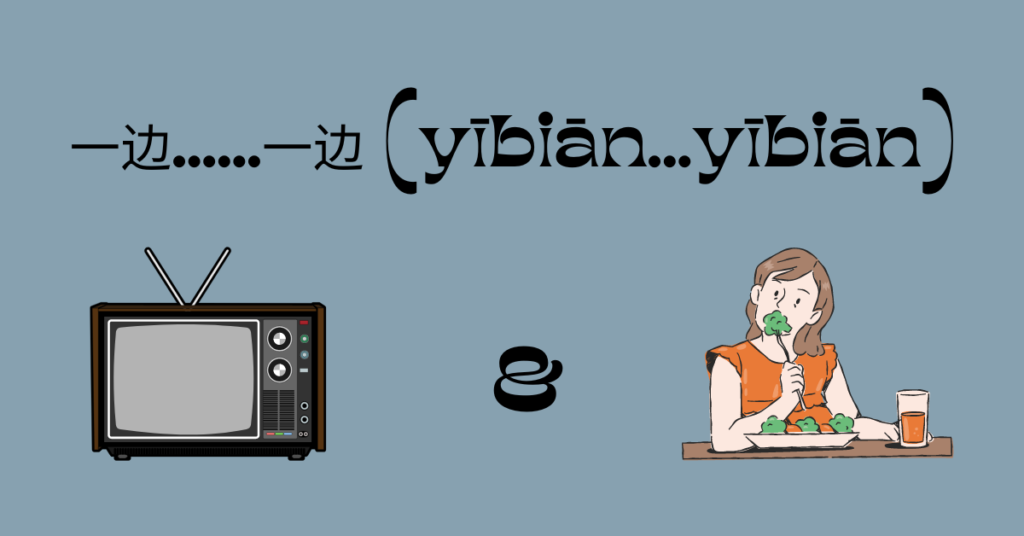
Here’s a detailed explanation of the common Chinese grammar pattern 一边……一边 (yībiān…yībiān) to indicate two actions occurring at the same time, along with examples:
一边……一边 (yībiān…yībiān) to indicate two actions occurring at the same time:
Structure: This pattern is used to express that two actions are happening simultaneously. It is formed by placing 一边 (yībiān) before the first action, followed by the second action and another 一边 (yībiān).
Example: 我一边吃饭,一边看电视 (wǒ yībiān chīfàn, yībiān kàn diànshì) – “I eat while watching TV.”
In this pattern, 一边 (yībiān) is used to introduce the first action, followed by the first action itself. Then, another 一边 (yībiān) is used to introduce the second action. This pattern indicates that both actions are happening concurrently.
This pattern is commonly used in Chinese to describe activities or tasks that are performed simultaneously. It can be used with various verbs, allowing you to express actions happening concurrently. Here are a few more examples:
- 我一边洗衣服,一边听音乐 (wǒ yībiān xǐ yīfú, yībiān tīng yīnyuè) – “I do laundry while listening to music.”
- 她一边写作业,一边和朋友聊天 (tā yībiān xiě zuòyè, yībiān hé péngyǒu liáotiān) – “She does homework while chatting with friends.”
- 他一边开车,一边给我打电话 (tā yībiān kāichē, yībiān gěi wǒ dǎ diànhuà) – “He drives while calling me.”
By using the 一边……一边 (yībiān…yībiān) pattern, you can indicate that two actions are happening simultaneously, allowing you to describe concurrent activities in Chinese.
Dialogue
Person A: 你在做什么呢?
(What are you doing?)
(Nǐ zài zuò shénme ne?)
Person B: 我在一边看电视,一边做功课。
(I’m watching TV while doing homework.)
(Wǒ zài yībiān kàn diànshì, yībiān zuò gōngkè.)
Person A: 真能够兼顾两件事情,你厉害!
(You’re really able to multitask, impressive!)
(Zhēn nénggòu jiāngù liǎng jiàn shìqíng, nǐ lìhài!)
Person B: 是啊,一边看电视可以放松,一边做功课也能提高效率。
(Yes, watching TV helps me relax, and doing homework at the same time also improves efficiency.)
(Shì a, yībiān kàn diànshì kěyǐ fàngsōng, yībiān zuò gōngkè yě néng tígāo xiàolǜ.)
Person A: 我想学会一边跑步,一边听音乐,但我总是会分心。
(I want to learn to run while listening to music, but I always get distracted.)
(Wǒ xiǎng xuéhuì yībiān pǎobù, yībiān tīng yīnyuè, dàn wǒ zǒng shì huì fēn xīn.)
Person B: 慢慢来,一边做事一定要集中注意力,习惯了就好了。
(Take it slowly, when doing tasks, you need to focus your attention. You’ll get used to it.)
(Màn man lái, yībiān zuòshì yīdìng yào jízhōng zhùyì lì, xíguànle jiù hǎole.)
In this dialogue, the structure “一边…一边” (yībiān…yībiān) is used to indicate two actions happening simultaneously. Person B explains that they are watching TV and doing homework at the same time. Person A praises their ability to manage two tasks simultaneously. Person B mentions the benefits of relaxing while watching TV and increasing efficiency while doing homework. Person A shares their desire to run while listening to music but expresses difficulty in staying focused. Person B encourages them to take it gradually and develop the ability to concentrate on multiple activities at once. The use of “一边…一边” highlights the simultaneous nature of the actions being performed.
Exercise
- Come up with your own sentences using this grammar principle.